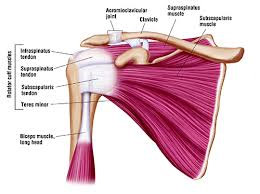
What is Shoulder Arthroscopy?
It is a minimally invasive method of performing surgery of the shoulder joint. The instrument is 4.5 mm diameter arthroscopy which is inserted through a small keyhole made over the skin.
The instrument has a camera and the structures inside the shoulder can be visualised. Another Keyhole is made depending on the surgery and requirement to insert implants and other instruments inside shoulder.

When do I need Arthroscopic Shoulder Surgery?
Arthroscopic surgery of shoulder is needed in following cases –
- Rotator cuff repair
- Bankart (Labrum lesion)
- SLAP tear (another variety of Labrum lesion)
- Shoulder instability
- Recurrent shoulder dislocation.
- Frozen shoulder (less common indication)
The muscles shown are attached to the shoulder and form a white tendinous structure just before insertion. This is called rotator cuff.

The rotator cuff muscles are responsible for abduction of shoulder primarily.
No.
There are few indications of MRI
Persistent shoulder pain
Any swelling in shoulder for which the diagnosis is not known.
Any weakness in shoulder movement
For pre-operative planning
Long standing frozen shoulder showing no improvement even after 6-8 weeks
It depends on the pain. If the pain is excruciating, then it will need urgent opinion from doctor.
If the pain is bearable and is relieved by analgesics (pain-killer medications), then you could do the following treatment at home.
- Take rest – You can get a arm pouch to support your upper limb through a sling around the neck. Avoid any active shoulder abduction or lifting heavy weight.
- Take painkillers – Painkillers help in decreasing the pain and they also have anti-inflammatory action.
- Cold fomentation will help in alleviating the pain.
Do Not do the following –
- Do not massage your shoulder – it may increase the swelling and stiffness
- Do not exercise your shoulder – You have injured your shoulder internally and hence the pain. Exercising will only increase your pain.
- Donot lift any weight. You can use a spoon or hold a cup but avoid lifting any weight heavier like a shopping bag or suitcase.
You will need to take rest for atleast 6 weeks. After 6 weeks we usually start gradual physiotherapy which involves active assisted mobilisation.
The protocol for physiotherapy and rehabilitation will change depending on the nature of surgery.
If the surgery is for frozen shoulder, then immediate post-operative physiotherapy with mobilisation is needed to prevent stiffness.
The post-operative rehabilitation and physiotherapy is an integral part of treatment after the surgery. We have an experienced Team of Physiotherapist who will guide you in gradual mobilisation and strengthening exercises of shoulder.
Usually full return to sports activity is possible after 6 months.
Like any surgery, there are some routine complications which are same for any surgical procedure and some special complications which are specific for procedure.
Overall the procedures are routinely performed and the complication are minor and treatable. These include infection, bleeding, need for revision surgery for re-rupture or tear, blood clots, injury to blood vessels and nerves.